Luis Pérez Ixoneztli interview
Luis Pérez was born in Mexico City on July 11, 1951. From 1971 onwards he dedicated much of his time to the research of the pre-Columbian instrumentation of Mesoamerica. This research allowed him to travel the Mexican territory and study musical traditions of the native peoples of Mexico. He learned directly from the living sources of the music and collected samples of musical instruments and the songs of different native speakers including Maya, Nahuatl, Mazateco, Yoemem, Comcaac, Raramuri, Wixarika and more.
His personal collection of native Mexican instruments includes ethnographic instruments still in use by ethnic groups, along with archaeological artifacts some of which are more than 2,000 years old. He continuously utilises these instruments in performances, concerts, lectures, exhibitions, and recordings, keeping them alive.
‘El Ombligo de la Luna’ delves deep into the past but also exists entirely outside of time, as Luis Pérez ‘Ixoneztli’’s offering to the world – the soul of Mexico channeled through the hands and heart of a master musician.
Where and when did you grow up?
Luis Perez: I was born in Mexico City where I grew up until I began traveling around age 18/19. Music was a big part of my family life in a sense that bohemian nights took place at my grandparents home on my father’s side regularly. I come from a family of bull fighters, two of my uncles were very famous at that time; Carmelo Perez who died as a consequence of a goring when he was bullfighting in Madrid… he was brought back to Mexico where he died… His brother Silverio Perez followed his steps and became a great bullfighter, due to his fame he was friends with many artists you know; singers, composers, actors etc. I suppose he favored musicians because of the bohemian sessions, those were the ones that came to the parties. I was about 2 or 3 years old, first grandson of my father’s parents Luis Perez and Carmen Soria, my father was their eldest son. I was born musician, at that age I knew how to sing, that was my first instrument, I supposed it was because of a curiosity seeing a child singing or I was cute or maybe both that I was invited to participate in those bohemian nights, I would be put on a chair and asked to sing to which I would reply, which one you want? I had a long repertoire, according to my mom 38 songs at that age, I can safely say that as soon as I learned to speak I learned to sing too. I remember listening to the great singers gathered at my grandparents home, also the musicians, mostly guitar players, I would stand right in front of them to see how they played their guitars enchanted by the sound. I can clearly remember the sessions, lots of drinking, a cloud of cigarette smoke, music, joy… I must have felt something like, I belong here… Ever since the only thing I have done in my life is music for which I feel very fortunate and grateful.
Was music a big part of your family life?
There was no real musicians on my father’s side but there was talent, well, besides the bullfighters who were considered to be artists, my father’s brother Alberto was a creator of magnificent sculptures, my father himself was very talented with his hands too but he had a family being too young, he was 18 years old when I was born, ten more brothers and sisters came after me so, he had to work in order to support such a big family. On my mother’s side it was perhaps my great grandfather who was a musician, he played violin. I remember watching him play outside of his home in the patio on sunny days. It is said that he came to Mexico during the French invasion. He played the trumpet then, but he was not French, he was of Italian ascendance and possibly mixed with Spanish. My mother’s sister Eva played the organ, you see…talking about religion, on my father’s side they were catholic and on my mothers side evangelists, even though I was never encouraged to profess either one I visited both temples as a child, honestly I liked going with my mom to the evangelists because they sang songs and my aunt play the organ… I liked the music.
What was your first instrument?
Well, my first instrument was my voice as I mentioned earlier, I would sing along with the radio, mostly ranchero music or bolero type, years later when my father bought a record player I was able to sing other types of music. I was probably nine or ten years old when I would play with my brothers and sisters, [since I had many] “the rock band” with brooms as guitars, my mom’s kitchen dishes for drums, the table for piano and I would sing my lungs out. By then, I was exposed to more music styles. We lived just around the corner from my grandparents, [my father’s side] my dad liked tropical music since he loved to dance. Music from Cuba, Puerto Rico and Mexico of course, my mother loved romantic music in all styles. When I visited my grandparent’s home before we had a record player I discovered music they liked. My grandfather liked Louis Armstrong, some of my uncles liked classical music and opera, the younger ones liked Jazz and Rock so, I was exposed to all types of music but like I said, it was all pretend when I played with my brothers and sisters.
Who were your major influences?
It was when I started junior high when I was in second grade that I experience seeing some schoolmates musicians playing instrumental music on acoustic guitars during recess, me like a bunch of other kids would gather around them to listen… one day one of them said, we need a singer… I immediately jumped and said I am a singer! They were surprised and asked, do you know this song? [I guess it was a Beatles song] I sang it, the another and another… I knew all the songs and so, I joined the band. When I went to rehearse I realized they did not have electric instruments or drum set, just the acoustic guitars, actually three, one lead, one accompaniment and the third guitar was the bass… the adapted it by removing two strings, the drum set was made out of cardboard boxes and kitchen dishes, the only drum tool he had was a foot pedal… but I was happy being the singer of a band. My parents were happy that I was in singing in a group. They met my colleges and knew they were good kids… one day my father surprised me, he had made a huge effort and bought me an electric guitar and and amp, a very cheap guitar but still, an electric guitar! The amp was fairly small, the size of a radio but it work just fine. I did not know how to play the guitar so, I remember seeing a manual that show how to play chords on the guitar at the newspaper magazine around the corner. It was the time to buy it and this is how I taught myself how to play my first instrument.
My major influences when I was in my first band when I was in junior high were; The Beatles, Kinks, Buddy Holly, Cliff Richard, Dave Clark Five, James Brown, then The Yardbirds, The Troggs, Them and all those bands that were playing on the radio… or not.
You were in several bands back in the seventies. You formed La Verdad Desnuda and later joined Ciruela.
Yes, back in the early seventies I was playing professionally in rock bands. I say professionally because we were making records, playing in venues, touring etc. In 1971 I formed a group, La Verdad Desnuda.
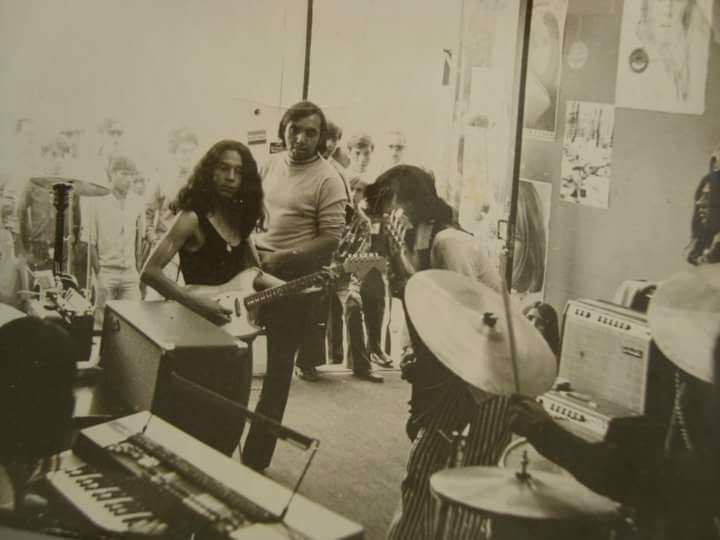
I was the composer, vocalist and guitar player in this band. I got a record deal with Polydor to record my own music. It was a 45 rpm record with three songs in English. The title was simply ‘La Verdad Desnuda’, before this I had been playing with several bands always trying to convince them to play original music, well… my own compositions since I was already writing… With La Verdad Desnuda I was trying to look for a musical style which could make me different from the rest but I was not quite sure on what, it was simply an impulse, a desire.
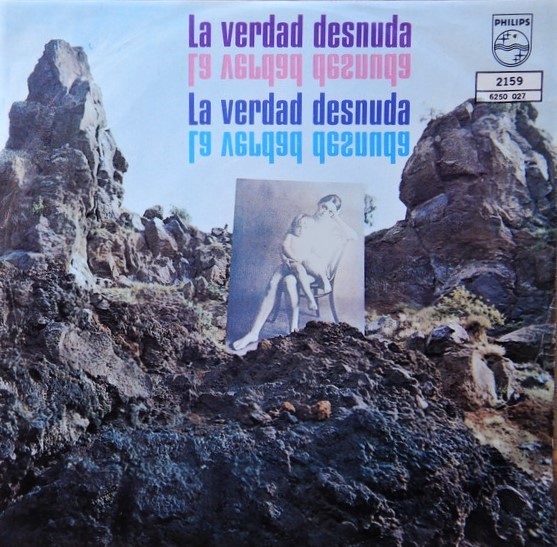
The music I was making was still strongly influenced by the bands I was listening during that time; Led Zeppelin, Deep Purple, Jimi Hendrix, Grand Funk Railroad etc. Even when I recorded with Ciruela the next year in 1972 those influences were still very present, but I was beginning to see a different option by bringing some elements from the indigenous cultures.
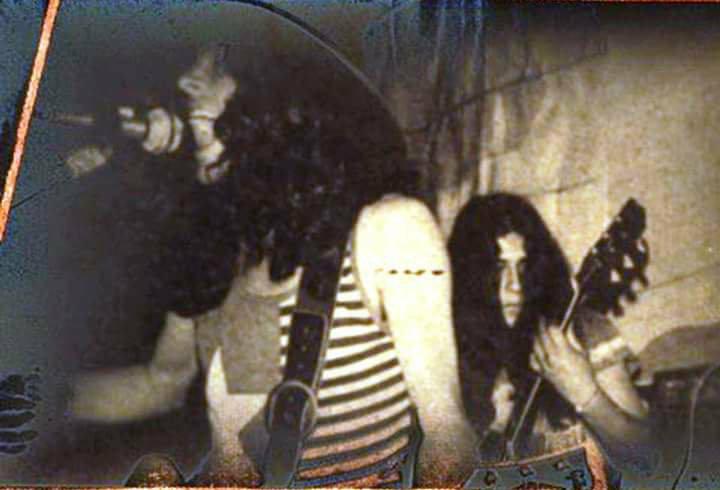
Ciruela had started a record with the company Cisne and Raff. It was a whole album. The musical influences were already stablished by the original members of the band. I was invited by the original and only member who left from that band to finish the album. I invited my colleges from La Verdad Desnuda except for the drummer for obvious reasons and we finished it according to the same style.
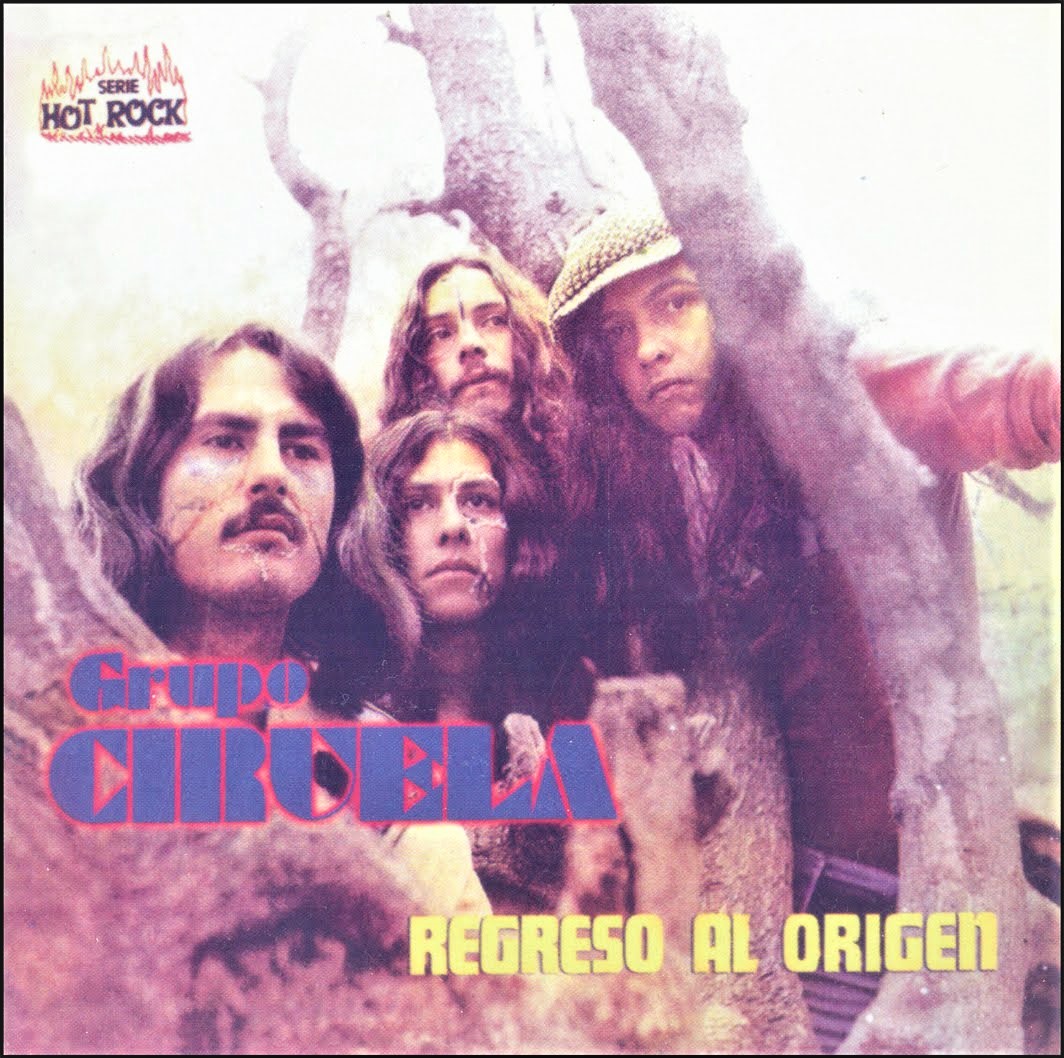
Then we were offered to record one piece of music for a single, one already existing song from the original album and a new song for side ‘B’ side which I composed in collaboration with a guitar player friend of mine Billy Valle. The title was ‘Hospital para Dementes’… some sort of a sci-fi story. The interesting thing about this song is that I was already experimenting with native Mexican rhythms and instruments, for this song it was mostly influenced by the dance rhythms used by the ‘Concheros’ a group that performs traditional music and dance in a syncretic manner during important celebrations that take place in churches. This was really my first recording where I am testing my intentions of integrating traditional Mexican music and native instruments with contemporary music, in this particular case, rock.
“I began collecting native instruments around 1971-72 with the firm intention of integrating indigenous music to rock & roll”
I recorded more music following the same vein during that year of 1972. This was when I was part of the ex-president’s of Mexico son band… Alfredo Diaz Ordaz… I composed music for his epic poem ‘Apocalypse’ integrating more native instruments; drums, flutes, rattles and rhythms with electronic instruments and rock band; synths, B3 Hammond organ with Leslie, electric guitars etc. We recorded the basic tracks with plans to do overdubs but this never happened, I left the band and lost track of those recordings, I don’t even know if they still exist….
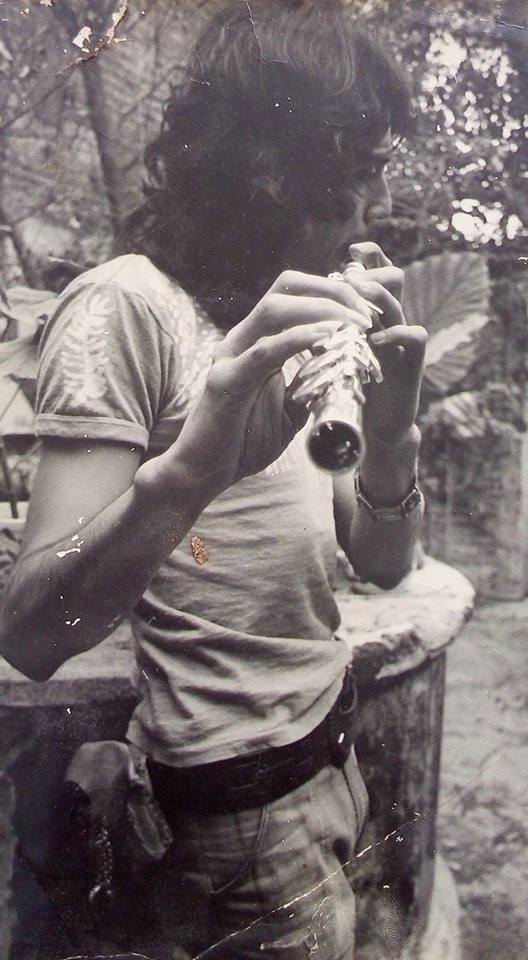
Well, with Ciruela I was playing transversal flute, an instrument I began studying while I was in the national school of music, UNAM. I also began collecting native instruments around 1971-72 with the firm intention of integrating indigenous music to rock & roll… or so I thought. The decade of the 70’s was tough for music, particularly for rock music in Mexico. There was rejection for this type of expression, particularly from the government. There was not enough places for work. We would play concerts in schools, the university festivals for free or almost for free. When we played in venues we were ripped by the organizers. Sometimes after our performance we would go looking for the organizers but they were already gone with the money. We as a band, did not have instruments except for maybe each guitar player his guitar, me my flute but no drums or amps so, when we got hired to play venues we would ask members of the bands that played before us to borrow their instruments, actually, the record we did for Polydor was with instruments we borrow from a music store where the manager was a friend, yeah, the name of that store was Casa Thiel in Colonia Roma. Still, with all this we had fun doing what we did playing in festivals for a great number of people or inside crowded venues or even in small auditoriums in universities.
“I was particularly focused in finding descriptions about music and musical instruments, vocabulary related to music, names of musical instruments etc.”
You dedicated most of your time to research the pre-Columbian instrumentation of Mesoamerica. This research allowed you to travel the Mexican territory and study musical traditions of the native peoples of Mexico.
I am neither a musician nor a researcher, specialist or other that was educated in academies, like I mentioned before my intentions when I signed up the school of music was to study ethnomusicology, unfortunately that career did not exist at that time. I realized that my option would be to learn on my own, particularly everything related to ancient music and instruments. I was not interested in pursuing a career in archaeology neither so, I began doing my own research, first; reading the books the first Spaniards wrote narrating the events related to the conquest of Mexico; Fray Bernardino de Sahagun, the soldier Bernal Diaz del Castillo and Fray Diego de Lands came first. I was particularly focused in finding descriptions about music and musical instruments, vocabulary related to music, names of musical instruments etc. Then, I would visit the museum of anthropology and history in Mexico City on many occasions, looking through the different civilizations identifying some of the instruments mentioned in the chronicles, the different periods of time, geographic location and everything I could absorb particularly about their musical instruments… I looked and examine very closely objects that looked like musical instruments but were not described as such, some of the cards simply read… ceremonial object… I discovered that they were indeed ceremonial objects more specifically ceremonial instruments. I would make drawings and take notes but I was always intrigued on… what do they sound like? Where can I find them?
I began traveling to near by towns at first learning about the surviving music that was performed during celebrations, this is how I got to know the ‘Concheros’ my first direct influence, then I went to see the Chirimiteros since their instrument Chirimia was frequently mentioned in association with Pre-columbian instruments, in time I learned that it was a primitive oboe introduced by the Spaniards. I found some reed flutes, rattles and small drums but no clay instruments like the ones I’d seen in the museum. It was in Teotihuacan, near Mexico City where I found people selling some clay flutes and whistles, I asked them about the makers, it was a long story but I finally made it to some workshops where I purchased a few. I was able to distinguish the sounds of clay flutes and whistles from reed and wood, then I travel to Amecameca, a small town in the state of Mexico near the volcanoes, there was a young girl selling wooden statues… effigies of saints… but she has some small hollowed trunks, Tepnonaxtlis… I had used some of this for the recordings of ‘Apocalipsis’ with Alfredo Diaz Ordaz… I asked her about the maker, it was her dad Maximino Ibarra, she told me how to get to see him, I went there, we sympathized and I asked him to make me a big teponaxli, from that day on he has built many hollowed trunks for me and many skin drums as well. Once in a music store in Mexico City I saw some clay instruments for sale, I tested them; a zoomorphic globular flute, a triple flute and a tubular flute, I bought them and asked who was the maker, they gave me information and I went to Texcoco where I met Mario Cruz, he made me many instruments ever since. I collected more clay instruments during my travels in Chiapas, Guerrero, Oaxaca, Michoacan and other places but they were mostly clay whistles or simple flutes, occasionally a clay trumpet. I had read some of the historians after I read the chronicles, seen instruments in the museum of anthropology, seen pictures in the books, I was familiar with morphology and organology of many instruments but the mystery remained… how do they sound like… sounds of replicas were not enough.
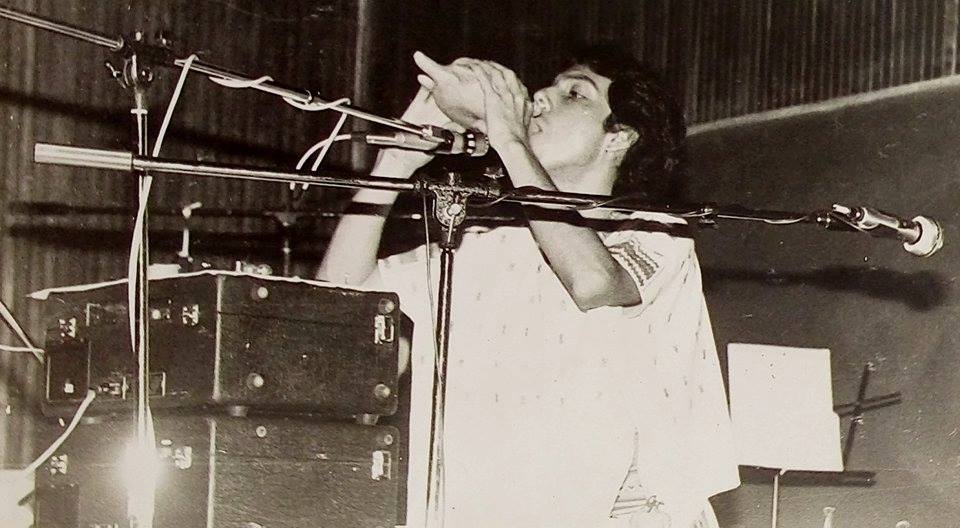
“The basic concepts honored by my ancestors are still the same concepts they believe in”
You learned directly from the living sources of the music and collected samples of musical instruments and the songs of different native speakers including Maya, Nahuatl, Mazateco, Yoemem, Comcaac, Raramuri, Wixarika and others.
It took ten years of my life dedicated to research into the realms of ancient music and instruments and experimenting with sound and music before I found the final fusion results by blending the native Mexican instrumental and the electronic technology available during the decade of the 70’s and early 80’s portrayed in the release of my first solo album ‘Ipan In Xiktli Metztli’, during those ten years I had traveled and visited several native communities in order to learn from direct sources… I was fortunate enough to witness rituals and ceremonies where they performed with their instruments, sang their songs and in more secluded occasions sang their prayers. I learned some of those songs, music styles performed on percussion instruments and some melodies they performed on their flutes while buying from them some of the instruments used during the ceremonies and at the end of such ceremonies. I especially learned that the basic concepts honored by my ancestors are still the same concepts they believe in and honor in their rituals, festivities and ceremonies… their close connection with the natural world, their love and devotion to the elements, the creatures they hunt for food, the plants they grow being the basis of all of them the sacred plant maize, their awareness of the movement of celestial bodies since agriculture depends on such precise observations… a lot of things may have changed through the centuries but Cosmogony is alive! I never experienced any discrepancies from the people in any community I have visited, I communicate with them through the divine language of music… this might be the reason why… it has always been our mutual love for music what connects us.
Since 2013 me and a team we created have been traveling back to the places I visited during the years of my youth with the purpose of making a long length documentary about those places; how have they changed in 40 years or so, have they been able to overcome the threats that come from; corruption… corporate greed from politicians who are selling their sacred lands to mining companies who offer jobs and material goods to the natives in exchange of their support while polluting and destroying their lands and ultimately when the natives refuse and protest this injustices they get killed, globalization is definitely there, younger generations want cell phones and video games, tv screens, computers, many want to travel North on a quest for a “better life” leaving their families behind, forgetting their traditions loosing their languages and ultimately their lives on the journey. But not all is lost… yet… there are places where the elders are still keepers of the sacred word, oral tradition and knowledge which they share during rituals in an effort to preserve their cultural heritage. Behind the veil of illusion there is still truth and hope. Our documentary is titled ‘Sanctuary of Butterflies’. The crew is small but determined to do a beautiful and truthful work of art. The movie director is Cole Smothers and the producer Daniel Sznajderman, they both live in New York. We have travelled many times to visit and film in native communities throughout Mexico. The movie is about music, dance, songs, rituals and more. And yes, after 40 years we are re-visiting; The Mazateco community in Huautla and the Mixtec-Zapotec in Oaxaca, the Yoreme and Yaqui in Sonora and Sinaloa, the Purepeche in Michoacan, the Maya-Lacandon in the jungles of Chiapas, the Chamula Tzotzil in the Highlands of Chiapas, The Wixarika in the sacred desert of Wirikuta, ancient cities and caves and much more.
Your collection includes a variety of ethnographic instruments and archaeological artifacts some of which are more than 2,000 years old.
My collection of instruments includes hundreds of samples of ethnographic connotation still in use by different native communities today. I was able to bring with me a lot of different instruments during my travels and some were purchased after their celebrations and festivities. I got some directly from constructors and some other ones were given to me as presents. Now, my collection of archaeological artifacts is mostly aerophones, they are representative of every single civilization and as a consequence every historic period of time; from the Olmecs, West Mexican Cultures, Maya, Mixtec-Zapotec, Toltec, Maya-Totonaca, Huaxtec, Teotihuacan and Aztec. The collection includes from very simple whistles to multiple flutes, this means a triple zoomorphic flute from the Maya, there are globular flutes, tubular flutes both; pentatonic and chromatic, zoomorphic and anthropomorphic, double whistles with and without finger holes, air spring whistles, conch shell trumpets and more. The collection includes some percussion instruments such as; a fitomorphic membrane drum from West Mexico, a Mayan metallic bell; an alloy of silver and copper, some cooper bells from West Mexico, bone rasps, sea shell bells and some sonorous objects made out of bone, sea shell and coral.
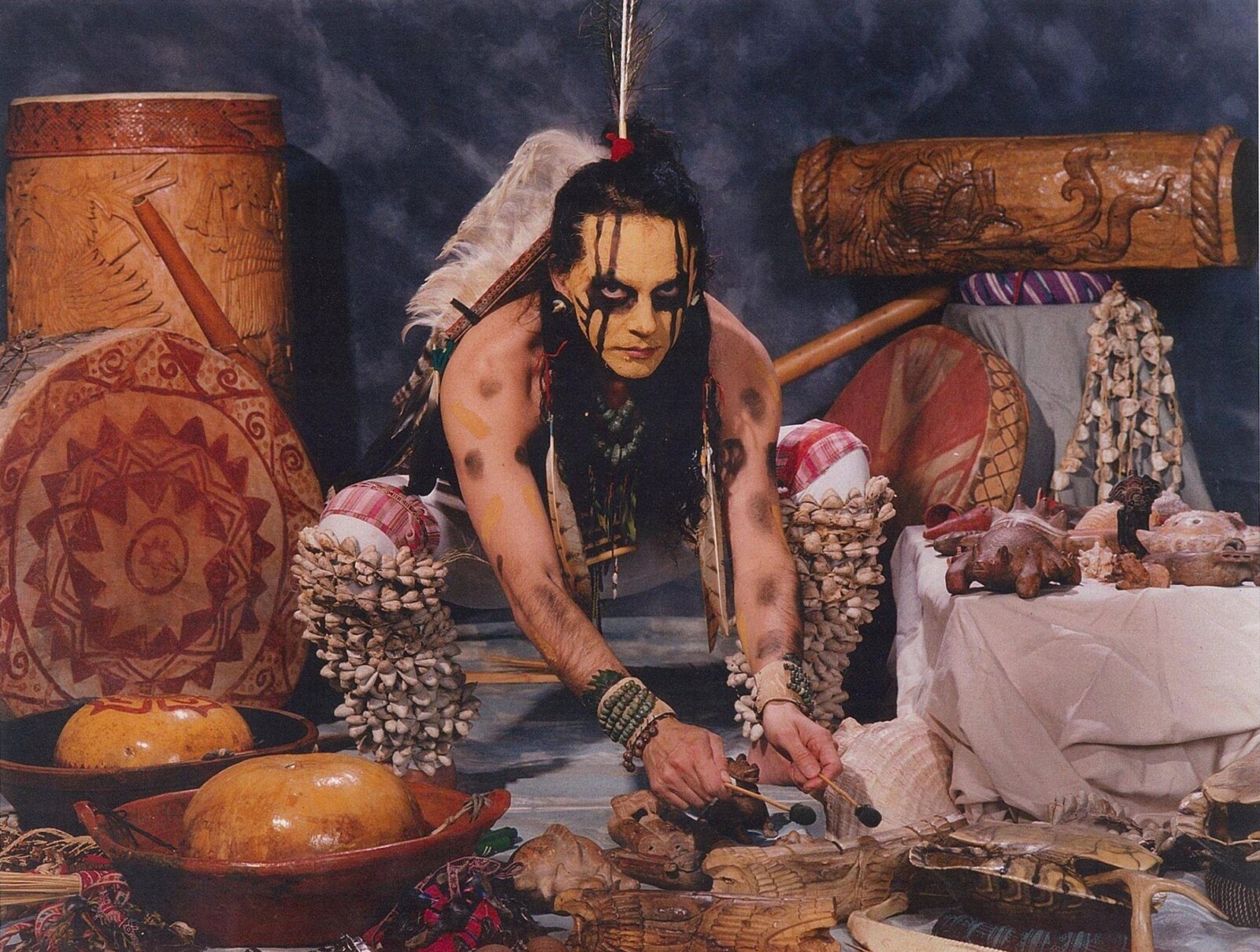
The instruments in my collection came after years I was researching, probably around 1976, some were given to me as presents from people in Mexico who had archaeological collections in their homes. One of my uncles gave me my first and second instruments, a pentatonic globular flute in the shape of a turtle and an open end anthropomorphic whistle, both from the Huaxtec culture, in time some other instruments came to me also as gifts, others were a result from trades. When I began traveling to the U.S.A. in order to participate in Symposiums of music in California at U.C.L.A. in 1981, right after the release of my solo album, I met professors and other specialists in Pre-Hispanic music, they were authorities at that time and I was fortunate enough to meet them. I sympathized with the then professor Peter Crossley-Holland who was in charge of the department of musicology at U.C.L.A. and one of the organizers of the First Symposium of Music from Mexico in 1981 in which the Mexican government was also involved, actually I was invited because of my record, it was considered to be a new type of Mexican music… and there I was.
It happened that professor and composer Crossley-Holland was very interested in West Mexico instruments, when he invited me to his home to see his collection I could not believe my eyes, I was totally stunned. He had hundreds of instruments in clay, sea shell, coral, bone and wood representative from the West Mexican Cultures; Colima, Nayarit, Jalisco, Michoacan, Guerrero and Sinaloa were all there, in one place, not behind windows but all perfectly arranged by regions. The best part was that I was allowed to touch them, and even better, play them!
Besides this amazing collection he had instruments from the Maya, Mixtec-Zapotec, Toltec, Aztec and much, much more. For the first time after all my visits to the Museum of Anthropology and History in Mexico City I was standing before an incredible collection of musical instruments and was able to smell the scent of clay after I put my breath in them, I was able to touch their textures, to look at every angle, study them and compare with descriptions I had seen in books of many, studying others and figure out how they functioned… I spent hours with Peter, exchanging points of view, ideas, knowledge, his presence in my life inspired me for many years. The following year 1982 I was invited to the second symposium, this time I asked Peter if I could record with his collection to which he kindly agreed, the perfect time was an occasion when he had to travel to San Francisco… he lived in Sylmar at that time… He let me stayed at his home, I invited a friend who had a four track cassette recorded, he went there and we recorded as much music as possible, all improvisations. I would test the instruments, select them and we would get to work. I have all that music which was transferred from four track cassettes to Pro-Tools and I hope to release and share such an important document some day.
“The concept behind this is life and death, full and complete rendition to an ideal, devotion, sacredness, total delivery… madness too.”
You’re still using these instruments in your performances and recordings. ‘En el ombligo de la Luna’ is a result of your research, interest and instruments. What was the concept behind it?
Well, yes indeed, ever since the release of my album ‘En el Ombligo de la Luna’ I have continued to use and array of native Mexican instruments in my work, actually even before the release I was absolutely fascinated with those instruments, experimenting with their sounds all the time… +En el Ombligo de la Luna+ is the first result of all that… ever since whenever or whatever work I approach and of any kind always has the incursion of some instruments either in a minimal way of abundantly but they are always there. Now, the concept behind this is life and death, full and complete rendition to an ideal, devotion, sacredness, total delivery… madness too. You see, when I realized that what I had been looking for all my life, that musical language of my own, that desire and commitment to be different, to be myself, I discovered that I had an identity of my own and that all of this came as a gift from my ancestors. I could finally understand their message. I was overwhelmed by their legacy comprehending that I am [like everybody else] inheriting such a treasure… listening to the results of that fusion based on the use of such ancestral instruments I decided that I would dedicate the rest of my life to help disseminate their values through music, I would become a defender, a fighter, a guardian, a warrior… I had my weapon of choice, the one they gave me… music. So, I made a decision of not selling my work in order to survive. I would not become a prostitute of music, I would not take music to please the crowds but to humbly contribute to the divine.
“I was very thin, almost skeletal and loosing my mind but I dedicated all my time to music there, alone in my small room in the street of Peru.”
What’s the story behind your debut album? Where did you record it?
In order to fine tune my work, to make it almost perfect I rented a small room in the street of Peru in Mexico City. I had nothing but my instruments and a rough mattress where I slept, it was one of those places where rent is very low and so are the living conditions. I did not have a bathroom, I had to share an outside bathroom with the rest of tenants in the property. There was no shower. I had to wash with cold water filling up a bucket using a plastic container to wash and rinse. The street was noisy, public transportation and traffic during the day, people in cars would use their horns for nothing, vendors screams in the streets, sirens etc. it was total madness… everyday… and it continued at night time, there were street joints selling food with loud music from their radios, there was a wrestling arena just down the street, there were wrestling matches twice a week. I could hear the ovations and after the event people in the streets, worst of all… the street of Peru is located in a poor side of town as you can imagine from the descriptions above. At night time when traffic was slowing down groups of kids would gather outside in the streets to play soccer ball, it was not just the game but the all were under the influence of glue… they would use plastic bags with glue inside or pieces of cloth soaked in thinner ‘monas’ and the inhaled those substances, they were loud and very nasty sometimes, the dogs… gangs of street dogs would show up one gang on each side of the street, they were like pirates; wounded, crippled some missing an ear or an eye and they would fight just like that gang vs. gang, barking of course. So, I had no rest and this was driving me insane, to top all this, since I decided not to work only to survive but dedicate my life entirely to this new musical language I had found, I had no money, some family members and friends who believed in me were kind enough to help me with some money so I could eat, my ration during those incredible times were; an oval shaped can of sardine in tomato sauce, and powder milk… that’s it.. the can of sardine had to last me for a whole day so I divided it in two or three rations, I would dissolve powder milk in water from the faucet… this way I had protein and fat… somehow. I was very thin, almost skeletal and loosing my mind but I dedicated all my time to music there, alone in my small room in the street of Peru.
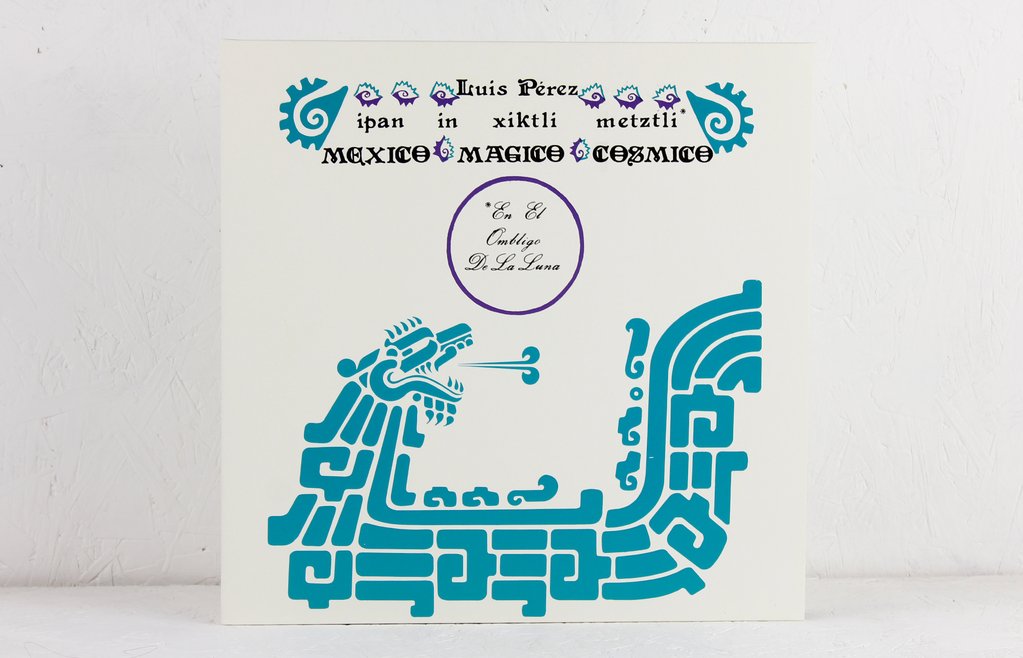
When I felt that I was ready, I went out to promote my work trying to get concerts through cultural institutions. I had no recordings not even on cassette and functionaries had no idea of what I was talking about, finally the university gave me a concert in one of their auditoriums, after that there was a place called Instituto Mexicano del Cafe in Reforma Ave. They were kind enough to give me three concerts, by the third concert the place was totally packed but that was it, only three concerts. I was desperate, hungry, frustrated even mad… one day a group of plastic artists came to visit my place in Peru, they told me that they had recorded one of my concerts and showed it to a functionary in the culture department of some institution and they wanted to meet me… So I went.
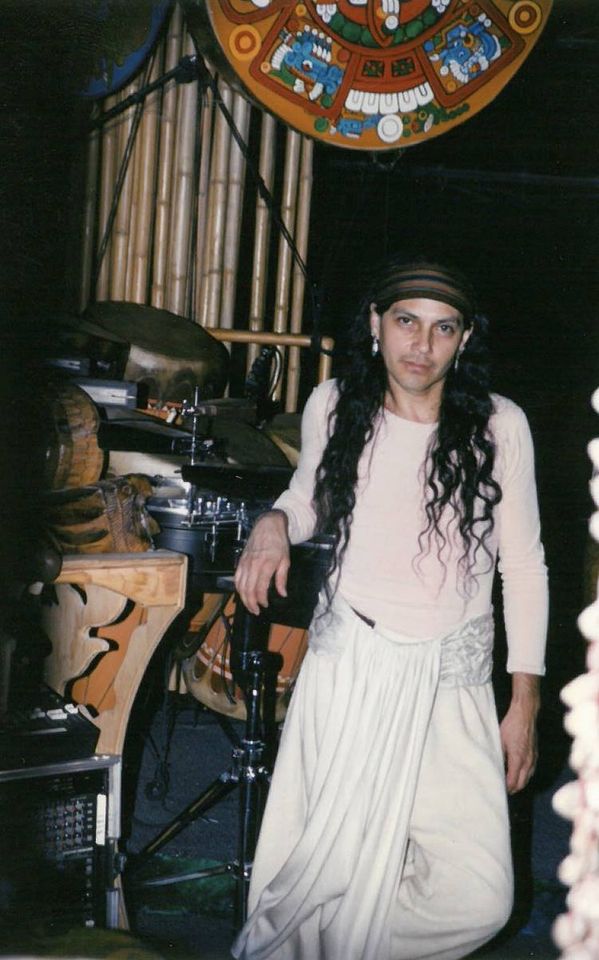
His name is Jose Facio Maldonado, he gave me a concert to test, he loved it then he gave me more in theaters, he knew of my situation and he hired me as a cultural consultant for the department he was in charge of… ISSSTE, Sudireccion de Action Cultural… he told me to find a decent place to live, to continue with my work and to eat decent and healthy food. I did, from that moment on ‘En el Ombligo de la Luna’ was being conceived as a work that soon enough would be recorded.
Regarding the story behind the record, I already shared enough but I will say that interested how I was in learning about my culture I knew of a place just around the corner where I lived after the street of Peru… I move to the Street of Tacuba still in downtown but a nice beautiful part surrounded by palaces, actually I live in one of them today it is a museum, anyway, around the corner in the street of Motolinia there was a place where people who were devoted to the Mexican culture would gather to study, among their studies they offered languages… I signed up to learn Nahuatl… the language of the Aztecs. In time we would be asked to write in Nahuatl, small poems, may teacher Izkalotzin Nieva Lopez shared with us a narrative about the foundation of the Great Tenochtitlan and birth of the the Mexica, I asked her if I could use that narrative for my work to which she agreed, this is how I composed side ‘B’ of my record, based and inspired by this poem, I had already composed side ‘A’ while I was living in the street of Peru, actually it was part of what I performed live, side ‘B’ reflects some of the chaos I experienced while the experiences in the street of Peru.
“ISSSTE originally pressed 5000 copies, they were not for sale, they were given a s gift to all Mexican ambassadors around the world, to all foreign ambassadors in Mexico, to all governors in the Mexican territory, all departments of culture and the president of Mexico at that time Jose Lopez Portillo.”
The album was recorded in three days in the Polydor studios, the same studios where I recorded with La Verdad Desnuda ten years before, since I knew some people there I thought that it would be a good idea to rent the studio for this project. We recorded the album on an eight track 2 inch tape device, the mixer was also eight track, this made it a little difficult when the time came to mix. The engineers were Francisco Miranda and Fernando Roldan. I was the music producer, composer and I played all the instruments. Jose Facio Maldonado was the executive producer representing ISSSTE. I can’t tell you the exact equipment used in the studio but the instruments I used besides the native Mexican ones were; electric and bass guitar, two delay units Roland; Space Echo 201 and RE-301 sound on sound, also three foot pedals, shin-ei volume pedal, phase shifter and ring modulator, both electro harmonic and one gong.
One curious thing… when I decided to publish a limited edition of my album back in 2013 or 15 [sorry don’t remember] You see, I had kept the final 2 inch tapes after the recordings and mis from 1981 to the date so, I contacted Francisco Miranda and asked him about re-mixing for the new limited edition, he said yes of course… I brought the tapes to his studio… Studio 19 in Mexico City, it happened that when Polydor went bankrupt he bought the equipment and so, the transfers were done using the same eight track device, mix was done partially in Pro-Tools and partially using the same mixer we used in 1981, the same engineers were there to mix Francisco Miranda and Fernando Roldan… mastering was done also in Studio 19… quite an experience.
How many copies were originally pressed?
ISSSTE originally pressed 5000 copies, they were not for sale, they were given a s gift to all Mexican ambassadors around the world, to all foreign ambassadors in Mexico, to all governors in the Mexican territory, all departments of culture and the president of Mexico at that time Jose Lopez Portillo.
Were you inspired by psychoactive substances?
I was not inspired by psychoactive substances when I created the album. I participated in ceremonies where I ingested Sacred Plants years before; peyote with Wixarika Marakame and mushrooms with Maria Sabina in 1984, after that I stopped using that delicate and sacred medicine.
I developed such profound respect for that medicine after I met the priestess Maria Sabina that I decided that I would not touch those plants again unless it was for a good reason, when I really needed it and always under the supervision and guidance of a holy person.
How pleased were you with the sound of the album?
Well, as I said before there was no other musicians involved in the creation and recording of ‘En el Ombligo de la Luna’, just myself so, I was happy with the results back then and I would not change anything in its content today.
Mr Bongo did a wonderful reissue.
Mr. Bongo did put a lot of heart and effort in the new edition of ‘En el Ombligo de la Luna’, it was thanks to our mutual friend Carlos Niño that Mr. Bongo became interested in my work. They offered to re-issue an album exact to the original and they did! I remember that I did not have a copy of the original myself so, my friend Carlos was kind enough to do some research and found a copy in decent shape. He actually scanned all the parts and sent it to Mr. Bongo.
I was always notified on the status of the art work, they sent me copies of the process for color and every detail involved. I remember that they even asked for the piece of paper with instructions inside the sleeve which I had forgotten. That was an idea of Jose Facio. He elaborated the instructions and even though I did not want, he convinced me that it was important. All and every text was sent to me in case it needed corrections, it was never the case, they even put special attention to the stamp on the record itself, color text everything! This has been an extraordinary achievements and I am very grateful to all the people involved at Mr Bongo, my friend Carlos Niño, the engineers for their beautiful work re-mixing and mastering. Thank you all!
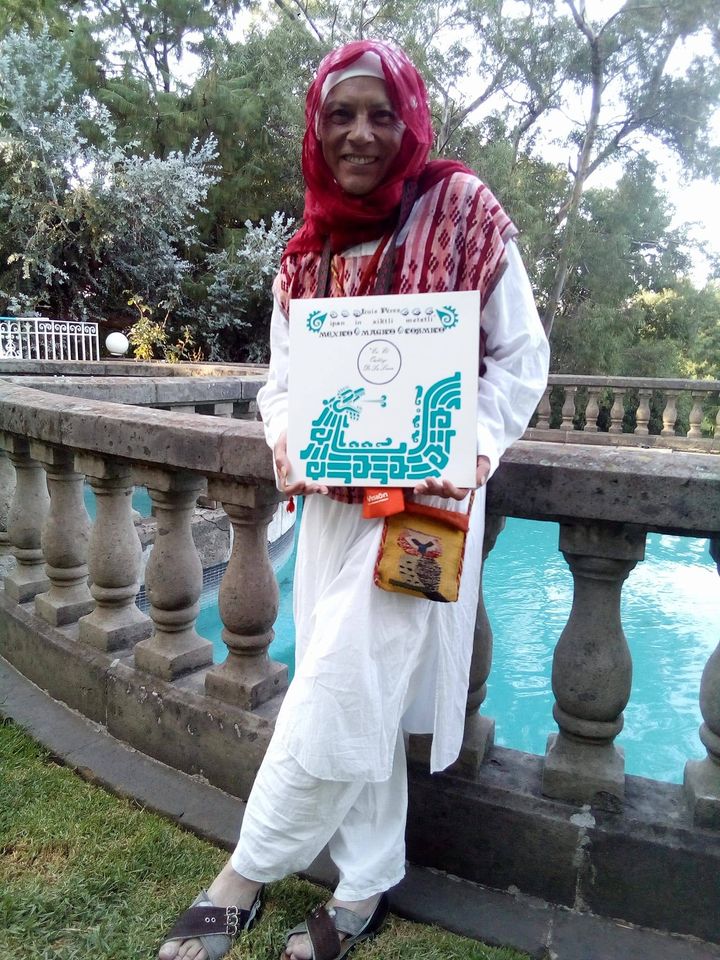
It’s absolutely impossible to cover your discography. You appeared on many albums. In the eighties you formed Huayucaltia. What’s the story behind this group?
I moved to the U.S.A. in 1987. I had made some friends from the years before, musicians, journalists and radio hosts, when I was part of the symposiums of music at U.C.L.A. newspapers wrote some nice reviews about my live concert while at the university and my record. Tom Schnabel had a radio show in Santa Monica where he invited me to perform live and be interviewed. I was also invited at KPFK radio where I was interviewed several times and they played my music, there was T.V. too… all of this helped.
You also collaborated with Andreas Vollenweider, Strunz & Farah, Jon Anderson. What collaboration do you cherish the most?
When I was in Mexico I got a letter from some musician, Jorge Strunz, he had heard my work and was inviting me to do something together with him and his partner Ardeshir Farah, nothing ever happened until I moved to San Francisco in 87. I gave Jorge a call and he told me that they were precisely recording some demos, so, I flew to L.A. with my instruments, recorded with them and joined the band, they were simply known as Strunz & Farah. I was having some solo concerts in San Francisco but there was not enough work, at some point I found it necessary to move to L.A. I was playing in Jazz clubs with S.&F. In the band there was a third guitar player Ciro Hurtado, he told me that he also had a band and invited me to join which I did, the band name was Huayucaltia. Their music was strongly influenced by the Andean folk mixed with some contemporary elements, Jazz and so. Huayucaltia got a record deal and I ended up recording with them in two albums and as a guest artist on their third… same happened with Strunz & Farah. I recorded with them a total of three albums, there was a lot of musicians coming to see us play at the Jazz venues, [Strunz & Farah] also producers who were interested in the band, this was before we got a record deal.
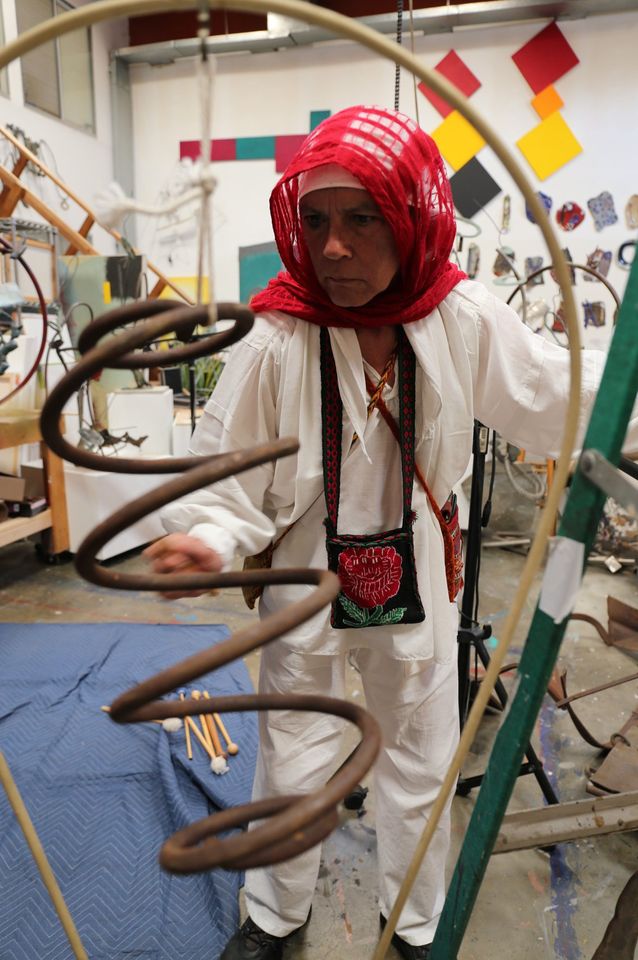
This is how I met David Lindley who invited me to record with Jackson Browne, then on a movie with composer James Horner and this is how everything started… on my part I was sending demos to different artists that I thought would be interested in collaborations, some replied some did not. I sent my work to Andreas Vollenweider… he did not reply until much later. I got a phone call from his manager who was in N.Y. inviting me to record with Andreas in L.A. Of course I accepted. We recorded at Mad Hatter studios for about three days for his ‘Dancing with the Lion’ album. After that I recorded with a lot of other artists; Barbie Benton, Wire Train and many others all while I was working as a studio musician recording for movies with composers; Terri Plumeri, Hans Zimmer and John Powell among others, then I met Jon Anderson through our mutual friend producer Gary Barlough. We travelled together to Chihuahua Mexico to visit the Rraramuri in the indigenous community of Basihuare. Jon was interested in native music of the Americas, this is how and why we met. We recorded ‘Toltec’ together and we went on tour to Mexico, Central and South America. I met Kitaro through Jon. I recorded with Kitaro on his album ‘Gaia’ then he offered me a record deal on his company Domo Records. Gary Barlough was the producer for my record ‘Tales of Astral Travelers’ for Domo. He was also involved in the production of ‘Toltec’ with Jon and ‘Gaia’ with Kitaro. In all I have recorded in about 40 albums in collaboration with other artists. In 1993 I joined the French Canadian Company Cirque du Soleil for the first permanent show in La Vegas Mystère. I recorded in both albums for the show; the studio album and the live album for which they brought a movable studio inside a trailer which was parked outside the hotel Trasure Island during the days of the recordings. I moved back to Santa Barbara in California after Cirque in 1996 to continue pursuing my career as a composer, this is when I recorded ‘Tales of Astral Travelers’ in 1998.
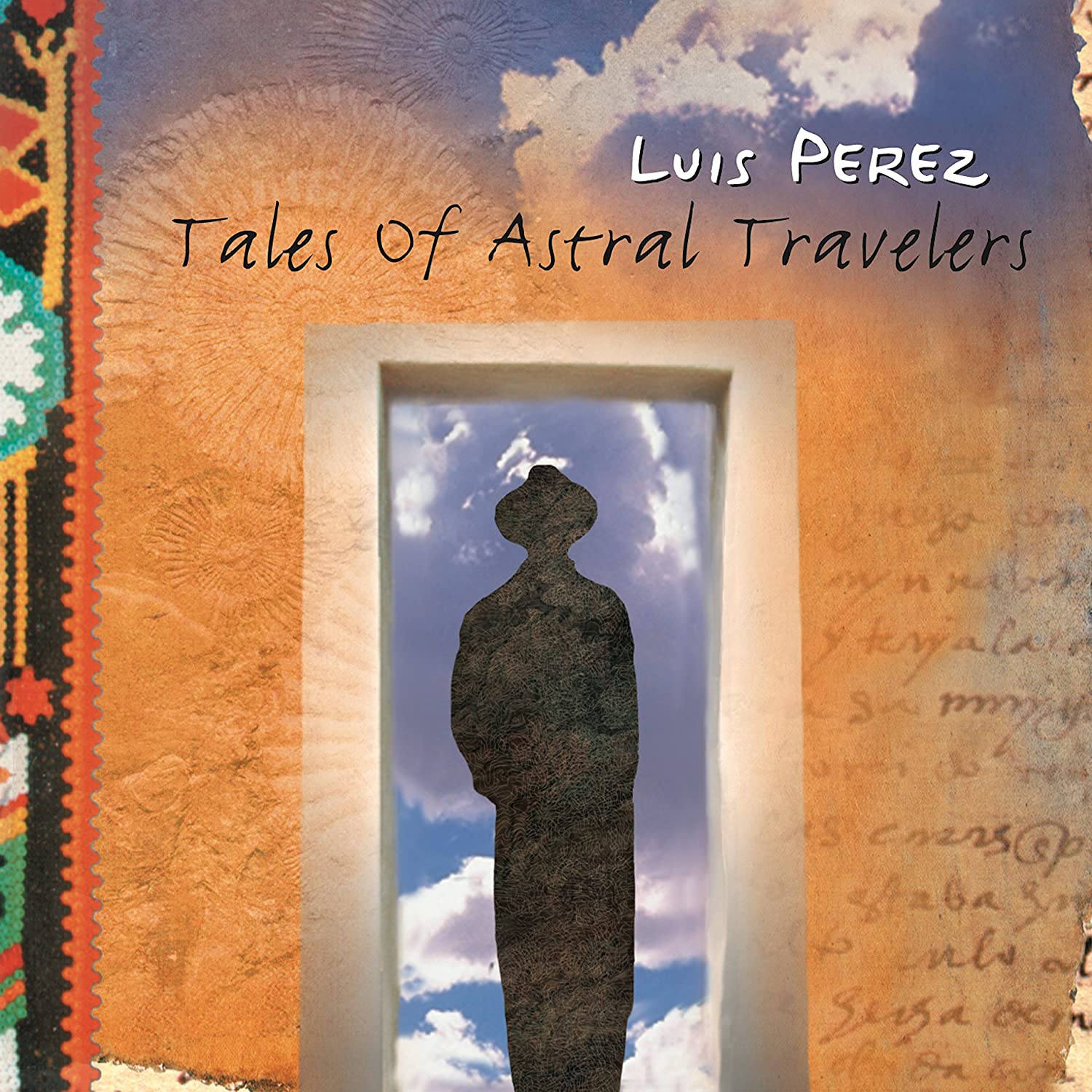
I really cherish all collaborations with the exception of Strunz & Farah… still it was a good experience… I particularly loved collaborating with Jon Anderson.
One of your latest recordings is ‘Mare Nostrum’. Would you like to share a few words about it?
‘Mare Nostrum’ is a double CD, a compilation of works I did as commissions for; theatre, dance and documentaries. I composed and recorded all this music while I was living near the ocean in the cities of Santa Barbara and Ventura.
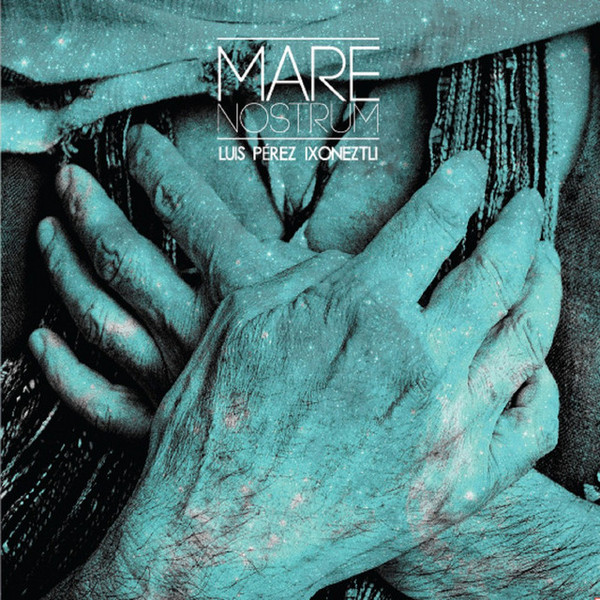
This is why of the title… ‘Our Sea’.
What currently occupies your life?
At present time I am composing and recording music for different projects, video games, documentaries and virtual reality among other things. I am also producing the work of other artists, mostly in Mexico. I just released two works in collaboration with North American musicians, one with Jesse Paterson. It is called ‘Aleaciones’ and the other with Benjamin Frederick Vukelic. It’s called ‘Icarus’.
Is there any unreleased material?
I would love to be able to find a venue to release the material I recorded in 1982 with the Peter Crossley-Holland collection of instruments from West Mexico… The word is out.
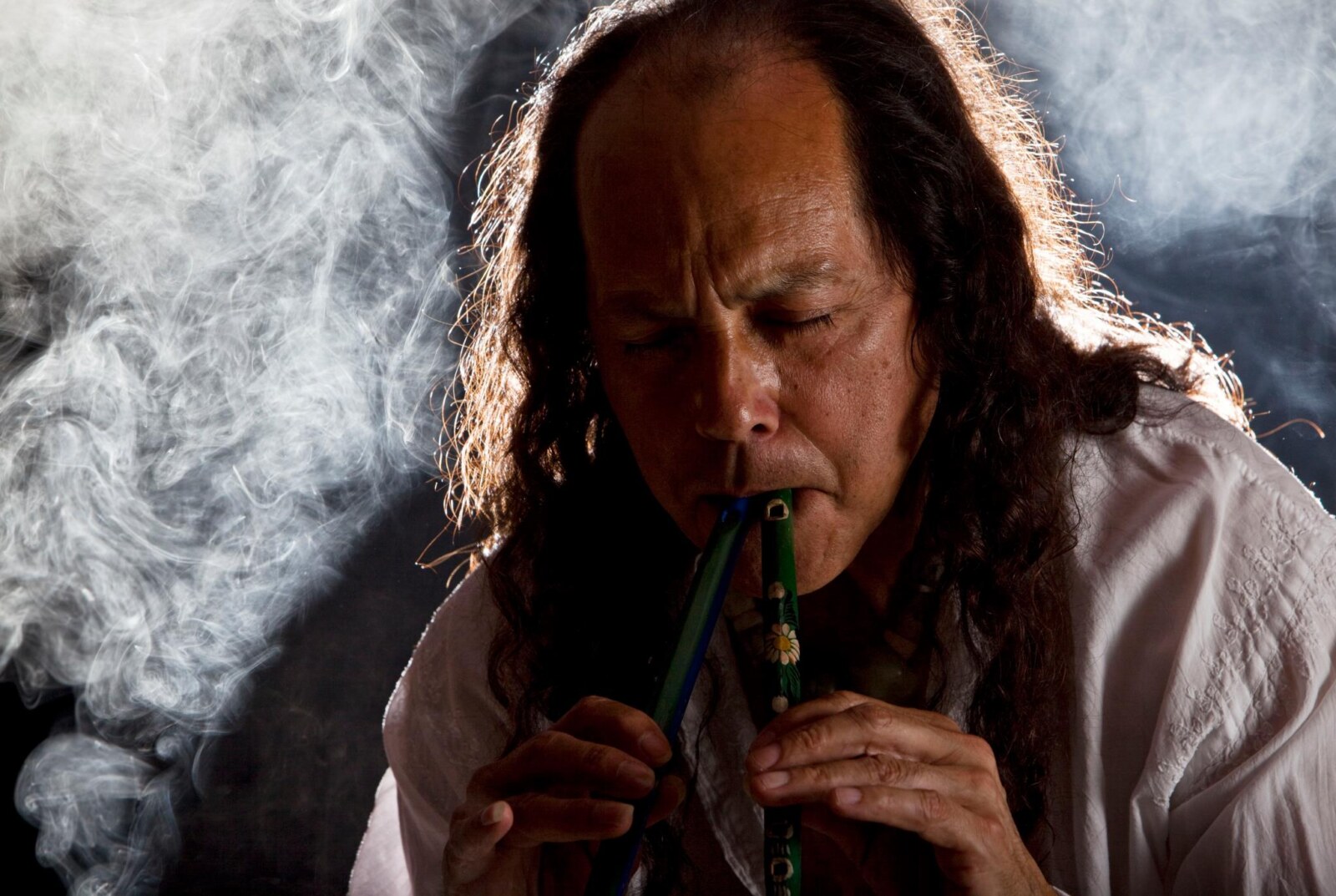
Thank you for taking your time. Last word is yours.
Thank you very much! Luis Pérez Ixoneztli
Klemen Breznikar
Tokonoma Records will release a new double LP Luis Perez album at the beginning of 2021. More info here.
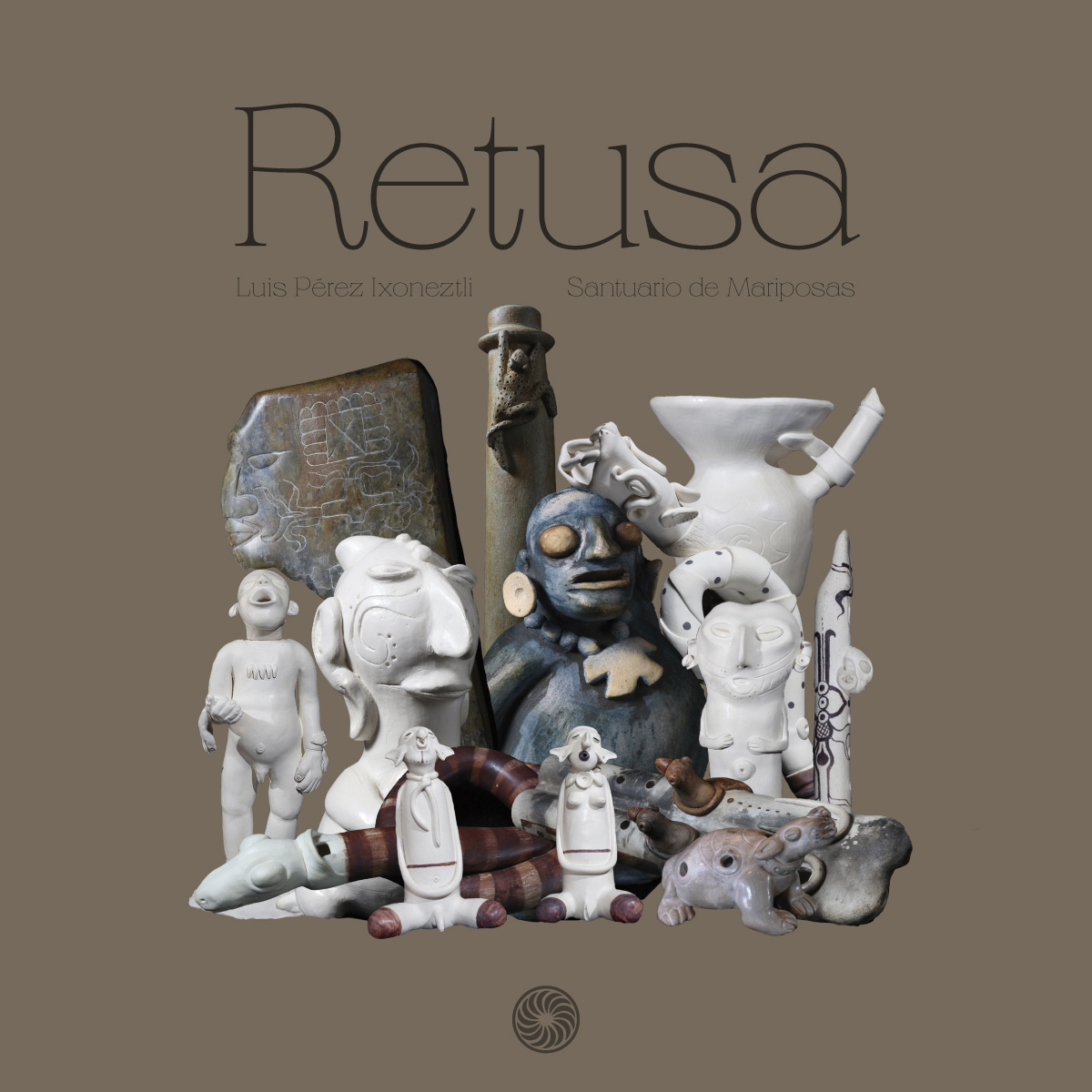
Luis Perez Official Website / Facebook / LinkedIn
Mr Bongo Official Website / Facebook / Instagram / Twitter / Bandcamp / YouTube / SoundCloud / Mixcloud
Tokonoma Records Facebook / Instagram / Bandcamp / SoundCloud

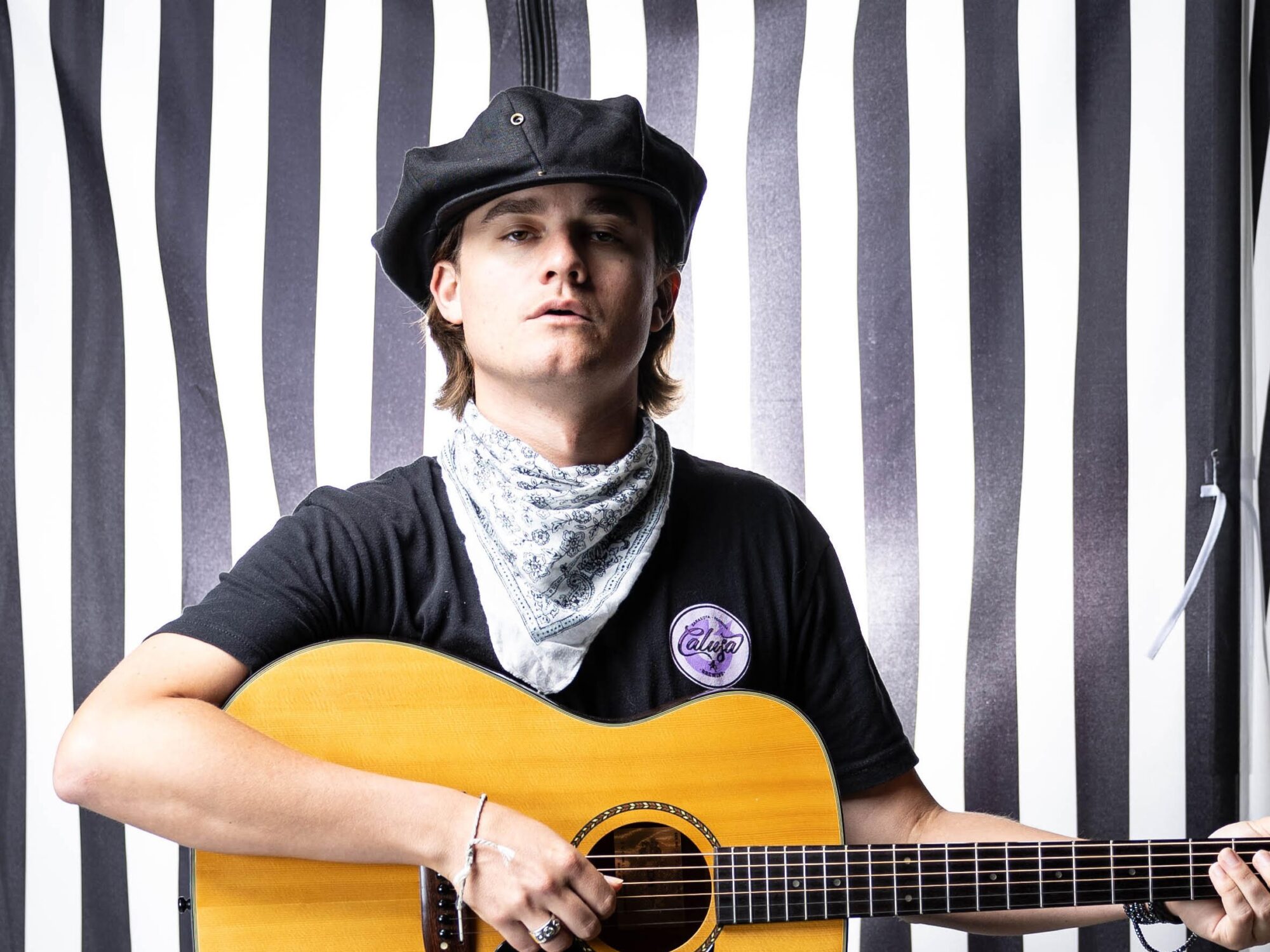
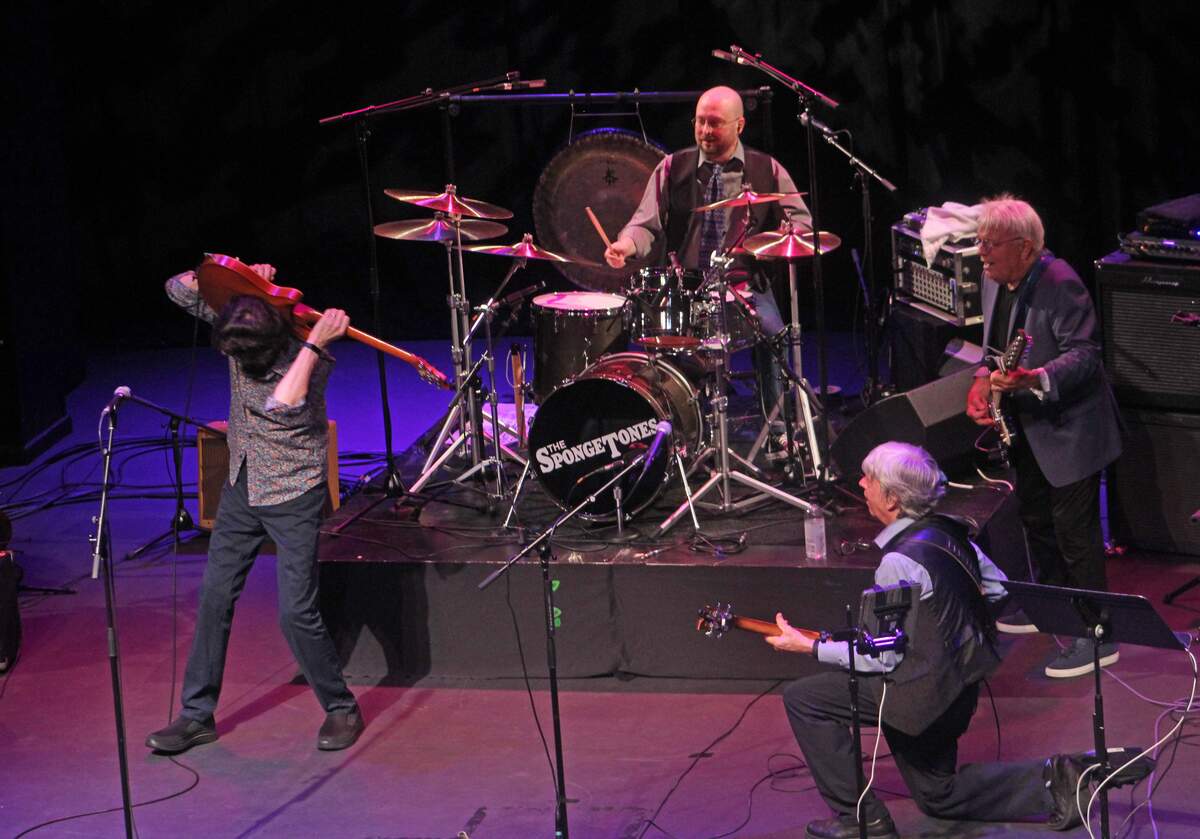
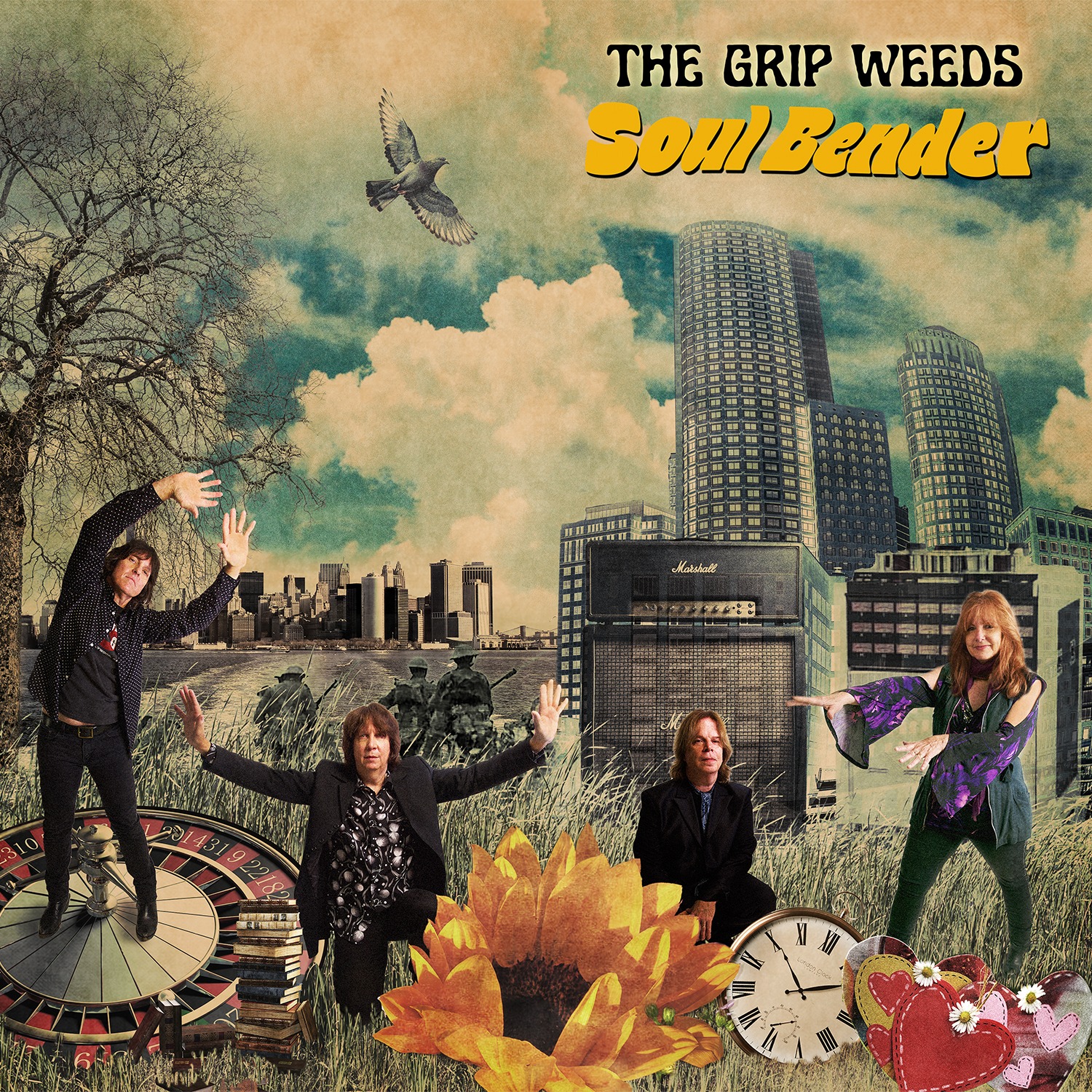
La voz ancestral llena de luz y desbordada de emociones que hacen ruido en el silencio. La entrega le liberta humana, la huella del viento y sus pisadas de memorias rupestres del paso de un guerrero que hace vibrar el ser aquí y ahora, un camino hecho a base de entrega y riesgos de vida. Admirable su trabajo; un ser auténtico y desbordado de pasión, libre de andar que se muestra en el espacio del aquí y ahora. Gracias por compartir tu sabiduria profunda y honda. Abrazos enormes y montones de flores y glorias en tu camino.